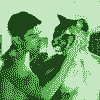
The Walrus Bldg.
In downtown Seattle, at the corner of Third Avenue and Cherry Street is this, The Arctic Club Building. The Arctic Club Building was once home to The Arctic Club, an exclusive community for those who traveled North during the Yukon Gold Rush and actually came back with gold.
To puncuate the Northern theme of the building, the architect festooned the pillasters betwixt the second floor windows with terra-cotta walruses. The walrus heads are at the top of wreathed cartouches. You may also notice the Alaska Building beyond at the corner of Second and Cherry. Seattleites harboured rather a fascination with the North back in the day. You'll find one of our numerous knicknames is "Gateway to Alaska,"
http://www.furnation.com/Ahundred/walrus2.jpg
Here's a shot from below. The Arctic Club building was completed in 1917 and is very Beaux-Arts, with wreaths and grapes and everything. Since I took this photograph The Arctic Club Building has undergone its fourth renevation to become The Arctic Club Hotel, (until then it was office space.)
http://www.furnation.com/Ahundred/walrus3.jpg
Here's a shot zoomed in from the top of the hill on which the building stands, at the corner of Fourth and Cherry. If you're wondering how I got the close-up shot of the walrus on the corner, I perched myself on the filthy parapet of that parking structure in the lower-righthand corner. I hate parking structures, but they're useful.
The fifth walrus from the left on the South side of the building is missing its right tusk.
To puncuate the Northern theme of the building, the architect festooned the pillasters betwixt the second floor windows with terra-cotta walruses. The walrus heads are at the top of wreathed cartouches. You may also notice the Alaska Building beyond at the corner of Second and Cherry. Seattleites harboured rather a fascination with the North back in the day. You'll find one of our numerous knicknames is "Gateway to Alaska,"
http://www.furnation.com/Ahundred/walrus2.jpg
Here's a shot from below. The Arctic Club building was completed in 1917 and is very Beaux-Arts, with wreaths and grapes and everything. Since I took this photograph The Arctic Club Building has undergone its fourth renevation to become The Arctic Club Hotel, (until then it was office space.)
http://www.furnation.com/Ahundred/walrus3.jpg
Here's a shot zoomed in from the top of the hill on which the building stands, at the corner of Fourth and Cherry. If you're wondering how I got the close-up shot of the walrus on the corner, I perched myself on the filthy parapet of that parking structure in the lower-righthand corner. I hate parking structures, but they're useful.
The fifth walrus from the left on the South side of the building is missing its right tusk.
Category Photography / Still Life
Species Unspecified / Any
Size 800 x 600px
File Size 102.7 kB
One, eighty years in the sun has faded the glaze a little bit. It was red originally. Two, I know classical revival buildings are alwasy bone white, but original classical architecture was brightly colored. Some architects try to emulate this, this building was originally yellow, red and blue and white but the red has faded to flesh and the yellow has faded entirely. Three, the cartouche has been in use since the classical era. Originally they were convex mirrors and were used indoors, their purpose was to reflect torchlight and skylight. Being as they had become a recrognizable shape, at some point two thousand years ago architects began putting them on the facade, sans the mirror. A fifteen hundred years of no interest in classical architectural, then BAM! Second classical age, otherwise known as the Baroque era. Everything is revived and elaborated upon. Revivalist styles flitter in and out over the next four centuries until culminating in the last unique classical revival, Beaux-Arts. Very popular here in Seattle. So, the architect carefully draws in various interpretations of classical ornament, with various elaborations in accordance with modern style and whatever the other architects are doing. It's meant to look like the recognizable shape of a cartouche, (convex mirror used to reflect torchlight,) crested by a walrus, instead of a greenman.
This is a cartouche in an Italianate setting, sans greenman.
http://teasmoke.net/sofar/photograp.....l-building.jpg
This is a cartouche and greenman in another Beaux-Arts setting.
http://www.furnation.com/Ahundred/Greenman.jpg
Basically, it's a joke. Instead of the traditional greenman it's a walrus. It was painted red originally because white would have been boring. Eighty years of sun made it flesh colored.
This is a cartouche in an Italianate setting, sans greenman.
http://teasmoke.net/sofar/photograp.....l-building.jpg
This is a cartouche and greenman in another Beaux-Arts setting.
http://www.furnation.com/Ahundred/Greenman.jpg
Basically, it's a joke. Instead of the traditional greenman it's a walrus. It was painted red originally because white would have been boring. Eighty years of sun made it flesh colored.
That is the stupidest thing I've ever heard. It's not even supposed to be pink, the building was just taken care of poorly in the last ninety years. And this is a very common form of decoration. If you knew anything about architecture or even looked up every once and a while you'd recognize it.
i'm not talking about what it used to look like or what form of decoration it is or whether on not i recognize it. i'm talking about what it looks like today. at this moment. in your picture above.
intent and outcome are rarely coincident. the architect may not have meant it to look like a stomach. that doesn't matter. what matters is what it does look like. check this link for more on that:
http://www.boingboing.net/2007/09/2.....ng-up-swa.html
maybe you should try to read what i'm actually writing, and not what you think i'm writing.
intent and outcome are rarely coincident. the architect may not have meant it to look like a stomach. that doesn't matter. what matters is what it does look like. check this link for more on that:
http://www.boingboing.net/2007/09/2.....ng-up-swa.html
maybe you should try to read what i'm actually writing, and not what you think i'm writing.
One notable aspect of Seattle architecture in our golden age, (from just after the fire in 1889 to World War II,) is the predominance of terra cotta. Terra facades were waterproof, fireproof, easy to mold into various architectural elements, and were available in a variety of bright colors, something of which we really took advantage once Art Deco came around. Manufacturing the terra-cotta bricks and tiles was a booming business.
The predominate styles depend on where you are, in Pioneer Square, the oldest part of town, Richardsonian Romanesque is the style, as much of the area was built in the eighteen-nineties. Facades were composed of ashlar, exposed masonry and unglazed terra cotta ornament. Newer buildings in that area were often built in the Italianate style, as not to clash with the existing structures. Elsewhere in the city gleaming terra-cotta Beaux-Arts, Gothic Revival, Byzantine Revival and Art Deco towers rose to the heavens, or as close to which the construction methods of the day would bring them.
In domestic architecture, the Craftsman bungalow reigns supreme. I can see eight of them out my window right now.
The predominate styles depend on where you are, in Pioneer Square, the oldest part of town, Richardsonian Romanesque is the style, as much of the area was built in the eighteen-nineties. Facades were composed of ashlar, exposed masonry and unglazed terra cotta ornament. Newer buildings in that area were often built in the Italianate style, as not to clash with the existing structures. Elsewhere in the city gleaming terra-cotta Beaux-Arts, Gothic Revival, Byzantine Revival and Art Deco towers rose to the heavens, or as close to which the construction methods of the day would bring them.
In domestic architecture, the Craftsman bungalow reigns supreme. I can see eight of them out my window right now.

 FA+
FA+



















Comments